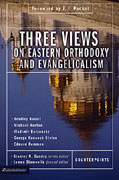 THREE VIEWS ON EASTERN ORTHODOXY AND EVANGELICALISM
THREE VIEWS ON EASTERN ORTHODOXY AND EVANGELICALISM
General Editor: James J. Stamoolis
Contributors: Bradley Nassif, Michael Horton, Vladimir Berzonsky, George Hancock-Stefan, and Edward Rommen
Among the more important developments in the Orthodox-Evangelical dialogue is: Three Views on Eastern Orthodoxy and Evangelicalism. The book was written by authors who are acquainted with each other’s faith traditions and are seeking to discuss the commonalities and differences between two quite different expressions of Christianity.
The title Three Views reflects the three possible positions/views: (1) Yes — Orthodoxy and Evangelicalism are compatible with each other, (2) No — Orthodoxy and Evangelicalism are incompatible, and (3) Maybe — Orthodoxy and Evangelicalism are possibly compatible. It is frustrating that the authors are left to determine the criteria for compatibility. Compatibility can be construed narrowly or broadly depending on how one wishes to define it. Thus, the book is vulnerable to inconsistencies in the way the authors arrived at their findings.
What makes Three Views so interesting are the personal backgrounds of the various authors. James Stamoolis and George Hancock-Stefan grew up Eastern Orthodox but converted to Protestantism. Bradley Nassif grew up Eastern Orthodox but experienced a personal conversion experience at a Billy Graham crusade. Edward Rommen was a Protestant missionary before converting to Orthodoxy. Michael Horton and Fr. Vladimir are solidly rooted in their respective religious traditions but evidence a keen awareness of what is going on “on the other side of the fence.” The focus of Three Views is primarily theological even though some of the authors digress into personal experience which enriches the content and dialogue underlying the book.
The book is set up so that each author states their position, the other authors provide their comments and critiques, and the original author then responds to or rebuts the comments. This means that reading Three Views can be a demanding and even challenging task. While each author has a particular point of view, all have sought to be scholarly and fair in their approach which means that those who share a common religious affiliation may find themselves surprised by the position or finding of their coreligionist.
This is not an introductory level book. This reviewer recommends that: (1) one first reads an introductory book like Through Western Eyes by Robert Letham, Light From the Christian East by James Payton, or The Orthodox Church by Bishop Kallistos Ware, and (2) attend worship services in both traditions. Three Views will be especially helpful for people who want to sort through the differences and weigh the opinions on both sides of the fence. See Resources page.
Coming Soon: Because the focus of the OrthodoxBridge is the interaction between the Reformed and the Orthodox traditions, Pastor Michael Horton‘s chapter is of special interest to us. In the next posting we will be responding to Horton’s reasons why the two are incompatible.
Robert Arakaki
P.S. Today marks one year since the OrthodoxBridge was launched. Thank you for your support!

very good. glory to God